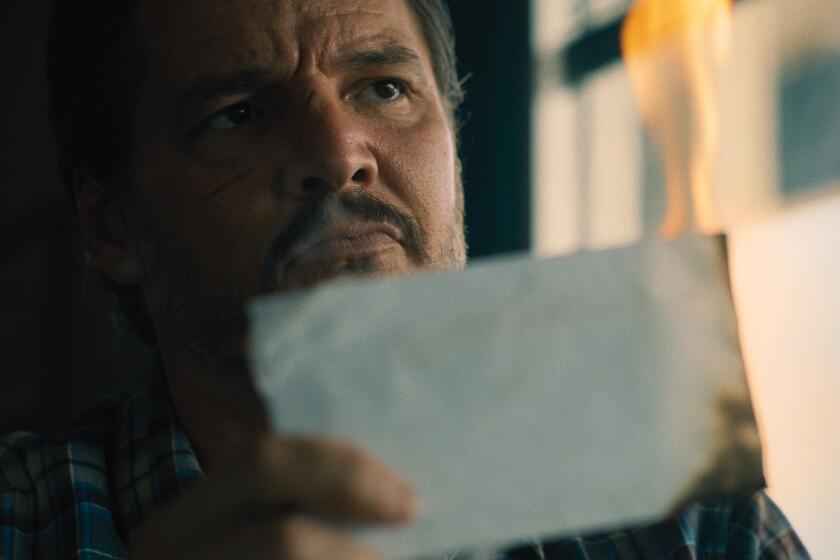Reelin’ in the Years With Real Film Buffs : Movies: About 300 fans gather in Hollywood for Cinecon 31, a four-day orgy of moviegoing, memorabilia and movie star appearances.
- Share via
The anticipation had built to a near-fever pitch. The buzz had been swirling for days. Hundreds of filmgoers of all ages lined up outside a Hollywood landmark for a chance to watch a much-touted film make its large-screen U.S. premiere.
And when the film’s heartthrob star appeared on the screen for the first time, the audience erupted into enthusiastic applause.
But far from the latest work of Brad Pitt or Antonio Banderas, the cinema aficionados were there Saturday night to see the original, restored version of the 1921 silent classic “Four Horsemen of the Apocalypse” starring Rudolph Valentino, who was still sending hearts aflutter 69 years after his death.
The film, with its melodramatic score preserved and its original color tints restored, was the key event at Cinecon, a four-day orgy of moviegoing, memorabilia and movie star appearances. The 31st annual convention of movie buffs was held Labor Day weekend at the Hollywood Roosevelt Hotel, site of the first Academy Awards show and home to Cinecon for the past six years.
“It’s a fantastic chance to see pictures from film archives that you absolutely couldn’t see in any other place,” said Dave Clayton, a San Diego writer working on a book about American movies of the ‘30s. “Most of what you see here is never going to show up on video in a million years.”
Cinecon 31 drew some 300 movie fans of all stripes for a program of about 40 films made between 1903 and 1952.
“They’re serious filmgoers, not just people going to see a movie to pass a few hours,” said veteran director Richard Fleischer (“20,000 Leagues Under the Sea,” “Tora! Tora! Tora!”), on hand to discuss one of his early films, “The Narrow Margin,” a fairly obscure but well-received 1952 film noir.
“I’m always surprised when I see so many people really devoted to motion pictures, not just as entertainment, but as a way of life,” he said.
Devotion to early Hollywood has been the distinguishing characteristic of Lamar McCarty’s 79 years. The retired accountant from Dothan, Ala., is a charter member of Cinecon/Society for Cinephiles.
“I just think I was born for this,” he said. “I started going to the movies at about 5 or 6. As a child growing up in a small, Southern town all there was to do was go to the movies. I’ve been going ever since.”
Norman Triplett, a 47-year-old clerk in the San Diego County public defender’s office, has attended Cinecon for the past five years. At the convention he proudly sported a Charlie Chaplin T-shirt and became fast friends with a Bay Area couple who were similarly decked out.
Film historian and critic Leonard Maltin credited Cinecon for stoking his interest in the medium. As a 14-year-old, he attended the second Cinecon ever held--in Baraboo, Wis.
“Maybe 75 people attended that one,” Maltin recalled. “It was a movable feast then. It depended on who would offer to host it.”
Surveying the gathering inside one of the hotel’s meeting rooms Thursday night, Maltin added, “There’s more knowledge about film in this room right now than anywhere in the world at this moment--and more love.”
One whose love runs deep is 83-year-old Edgar Williams, a Cinecon regular for all of its three decades. He likes to boast of his own vast movie library and speaks wistfully of the glory days of Hollywood when he booked movies at three elegant Los Angeles theaters that have since been torn down.
“The old days--you couldn’t beat them,” Williams said.
Dian Sharma, a 50-year-old legal secretary, has attended 17 previous conventions, making the trek yearly from San Francisco. She and her roommate scolded a memorabilia dealer for not having enough posters of their idol, Valentino. The pair had bought so many movie posters that they decided to wallpaper their kitchen with them, from floor to ceiling.
“We’ve been coming so long we know all the people,” Sharma said. “So, it’s just like a homecoming. We used to spend a lot more money. Now, instead of concentrating on memorabilia we see more films and have more fun. And it’s so good to see these movies in the style in which they used to be played.”
That’s where organist Bob Vaughn comes in.
Each year, the retired Immigration and Naturalization Service investigator returns to his roots as an organ accompanist for silent films. An old hand at the job--which these days calls for him to improvise tunes as he watches the movie--Vaughn began playing for silent pictures when he was in high school. His career in the movies was short-lived, however, because talkies began replacing silent films around 1930.
“It’s a good thing the silents canceled out,” Vaughn, 84, said with a laugh, “because I wouldn’t have made it through high school if they hadn’t.”
So knowledgeable were the fans that many of the special guests on hand, including directors, producers, screenwriters and actors, deferred to audience members on specific questions.
As director Fleischer and producer Stanley Rubin discussed the mere 13 days it took to shoot “The Narrow Margin,” they frequently would turn to the audience with a question.
“Was anyone aware of the score of the picture?” Rubin asked.
Several voices immediately yelled out: “There was no score.”
(True. The filmmakers had decided to use train sound effects, whistles and signals, but no music.)
Fleischer recalled how he simulated the motion of a train ride in which much of the movie takes place. The budget was tight at about $188,000--which even by early ‘50s standards was small--so there was no room for special effects.
“Every once in a while, when the spirit moved me, I’d shake the camera,” and that helped to create the jostling motion of a moving train, Fleischer said.
“That’s how we did it then--sleight of hand,” he said.
The audience applauded his ingenuity.
But the long weekend’s high point was the question-and-answer session Sunday afternoon with the feisty, wisecracking Sylvia Sidney, whose 1936 film “Trail of the Lonesome Pine” had just been screened. Sidney spoke of working with Henry Fonda, Alfred Hitchcock, Fritz Lang and, more recently, Tim Burton.
“I was about the only woman Hitchcock didn’t play terrible tricks on,” she recalled. “He had a tremendous respect for money. And when he found out I was making much more money than he was, he had tremendous respect for me.”
When an adoring fan lavished praise for her performance in the 1931 “Confessions of a Coed,” she cut him off with: “Ohhh, one of the worst films ever made.”
Sidney reminisced about working with Spencer Tracy, recounting how they would regularly meet at a speak-easy. Turning to the audience: “Yeah, I was alive during Prohibition.”
Sidney, 85, closed the session with a dictum for the audience: “I have a very important message: Old age sucks.” Then she disappeared before the autograph-hungry crowd could descend on her.
More to Read
Only good movies
Get the Indie Focus newsletter, Mark Olsen's weekly guide to the world of cinema.
You may occasionally receive promotional content from the Los Angeles Times.









